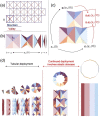Origami-inspired thin-film shape memory alloy devices
- PMID: 34040022
- PMCID: PMC8155017
- DOI: 10.1038/s41598-021-90217-3
Origami-inspired thin-film shape memory alloy devices
Abstract
We describe the design and fabrication of miniaturized origami structures based on thin-film shape memory alloys. These devices are attractive for medical implants, as they overcome the opposing requirements of crimping the implant for insertion into an artery while keeping sensitive parts of the implant nearly stress-free. The designs are based on a group theory approach in which compatibility at a few creases implies the foldability of the whole structure. Importantly, this approach is versatile and thus provides a pathway for patient-specific treatment of brain aneurysms of differing shapes and sizes. The wafer-based monolithic fabrication method demonstrated here, which comprises thin-film deposition, lithography, and etching using sacrificial layers, is a prerequisite for any integrated self-folding mechanism or sensors and will revolutionize the availability of miniaturized implants, allowing for new and safer medical treatments.
Conflict of interest statement
The authors declare no competing interests.
Figures





References
-
- MacGregor P, Lang R. Origami Design Secrets: Mathematical Methods for an Ancient Art. Cambridge: Cambridge University Press; 2013. p. 97.
-
- Ning X, et al. Assembly of advanced materials into 3D functional structures by methods inspired by Origami and Kirigami: A review. Adv. Mater. Interfaces. 2018;5:1800284. doi: 10.1002/admi.201800284. - DOI
Publication types
LinkOut - more resources
Full Text Sources
Other Literature Sources

